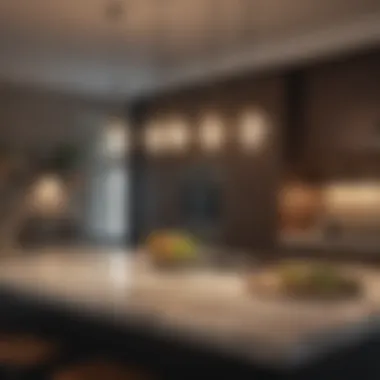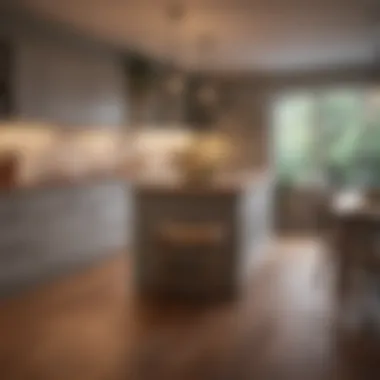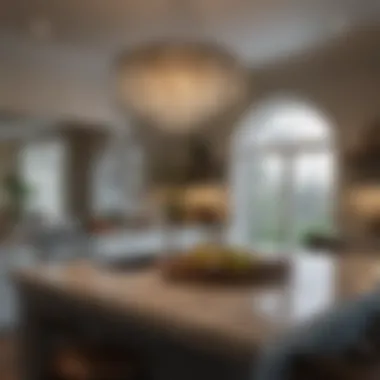Creative Kitchen Island Lighting Ideas for Every Space


Intro
Design Inspiration
Trending Styles
When it comes to kitchen island lighting, several styles have emerged as popular choices among homeowners and designers alike. Contemporary designs often favor minimalist fixtures that emphasize clean lines and simplicity. Pendant lights are a staple in modern kitchens, offering a blend of style and functionality. For a more traditional look, chandeliers provide a touch of elegance and can act as a stunning focal point. Industrial-style fixtures, with their raw materials and exposed bulbs, have gained popularity for those seeking an urban vibe.
Color Palettes
Choosing the right color palette for your lighting fixtures can significantly impact the kitchen's atmosphere. Neutral tones, such as whites, greys, and blacks, tend to create a sleek and modern appearance. These colors can complement various kitchen designs without overwhelming the visual space.
On the other hand, bold colors, like deep blues or vibrant reds, can add personality and create a striking contrast against a lighter kitchen backdrop. Consider warm-toned lights that create a cozy and inviting environment, especially for those who entertain regularly.
"The interplay of light and color can evoke emotions and set the mood in your kitchen. It’s essential to choose wisely."
Practical Tips
Maintenance & Care
Maintaining your kitchen island lighting is key to ensuring longevity and keeping your kitchen looking fresh. Dust and grime can accumulate on fixtures, reducing their effectiveness. Regular cleaning is important. Use a soft cloth to wipe down the fixtures and avoid abrasive materials that could scratch the surface.
Check bulbs regularly, especially if you use dimmable variants; they often require replacements more frequently. Also, ensure the wiring and connections are secure to prevent any electrical hazards.
Budgeting & Planning
When planning your kitchen island lighting, budgeting appropriately can help align your vision without overspending. Begin by determining the desired style and function of your lighting. Set a realistic budget that considers the cost of fixtures, installation, and any necessary electrical upgrades.
Consider exploring options such as pendant lights from brands like Kichler or Visual Comfort, known for their design and durability. Investing in quality fixtures from the start can save money on replacements and repairs in the long run.
Understanding the Importance of Kitchen Island Lighting
Kitchen island lighting plays a crucial role in enhancing the overall functionality and aesthetic of a kitchen. Proper lighting can significantly impact how an area is used and perceived. When planning a kitchen remodel or upgrade, homeowners should consider how light will shape their cooking and entertaining experiences.
The kitchen is often regarded as the heart of the home, a space where culinary creativity flourishes. Therefore, effective lighting is necessary not just for practical use but also for creating an inviting atmosphere. It can help delineate zones within the kitchen, assisting in the navigation and organization of space. Moreover, it adds style and character, reflecting personal taste and enhancing the overall design.
Role of Lighting in Kitchen Functionality
In any kitchen, lighting must facilitate various activities. This involves ensuring that work surfaces are well-lit for food preparation, cooking, and cleaning.
- Task Lighting: This type of lighting is essential. It focuses on specific areas, allowing for precision in tasks. For instance, pendant lights above an island can provide direct light where it is most needed.
- Ambient Lighting: This includes general light sources giving an all-around glow. It is important for creating a balanced environment. Ceiling lights, recessed lighting, or even large chandeliers can fulfill this role.
- Accent Lighting: This is used to highlight certain features, like artwork or decorative elements. It can add visual interest in the kitchen without being the main source of light.
By combining these types of lighting, homeowners create an effective, functional area that remains pleasant to the eye.
Aesthetic Considerations in Lighting Design
While functionality is paramount, aesthetics must not be overlooked. Kitchen island lighting can significantly influence the room’s ambience and style.
- Style Selection: Choose fixtures that align with the kitchen's design theme. For instance, industrial-style homes may benefit from metal or Edison bulb fixtures. In contrast, a modern farmhouse might lean toward softer, rustic designs.
- Fixture Positioning: The arrangement of lights must complement the kitchen's layout. Fixtures should not obstruct sightlines or feel out of place. Correct positioning creates harmony in the space.
- Color Scheme: The lighting fixtures should blend with the kitchen's color palette. For a cohesive look, choosing colors and materials that resonate with other elements in the kitchen is essential.
"Effective lighting transforms a functional necessity into a design feature that elevates the entire space."


By thoughtfully addressing both the functional and aesthetic roles of kitchen island lighting, homeowners can achieve a well-balanced space that enhances their daily lives.
Types of Kitchen Island Lighting
In selecting adequate lighting for kitchen islands, understanding the various types of fixtures available is crucial. Kitchen island lighting serves multiple purposes: it enhances functionality for cooking and food preparation, provides ambient light that defines the space, and adds a touch of style to the kitchen. Each type of lighting offers unique benefits and considerations for homeowners.
When choosing lighting fixtures, it is important to think about the layout of the kitchen. The amount of natural light, the size of the island, and the overall design theme can impact what types of lighting work best. The goal is to create a harmonious blend of function and aesthetics that enhances the kitchen’s usability and appeal. Several types of lighting options are available, including pendant lighting, chandeliers, recessed lighting, under-cabinet lighting, and track lighting. Each brings distinct characteristics and can greatly influence the overall ambiance.
Pendant Lighting
Pendant lighting has become increasingly popular in kitchen designs. Its versatility and practicality make it an excellent choice for illuminating kitchen islands. These fixtures suspend from the ceiling, often at varying heights, which allows for creative designs. They come in many shapes, styles, and sizes, offering options that can suit contemporary or traditional aesthetics.
The primary advantage of pendant lights is their ability to provide focused light. This targeted illumination is especially useful when preparing meals or performing other tasks at the island. Homeowners can select multiple pendant lights to create a striking visual effect, such as a cluster of lights in different heights. When considering pendant lighting, it's essential to choose a scale that aligns with the island’s dimensions. Larger pendants may dominate a small space, while smaller ones may get lost in a grander kitchen.
Chandeliers
Chandeliers have a classic appeal and can serve as stunning focal points in kitchen islands. While often associated with dining rooms, kitchen chandeliers can add elegance and charm when chosen correctly. They often come in larger sizes that align well with spacious kitchens, making them ideal for centers of social activity.
When selecting a chandelier for the island, consider the height of the ceiling to ensure adequate clearance. It's crucial that the chandelier hangs at a suitable height, providing illumination without obstructing views. Additionally, the design should harmonize with other kitchen elements, such as cabinets and countertops. Chandeliers equipped with dimming features can provide both bright task lighting and softer ambient light, adding to their usability.
Recessed Lighting
Recessed lighting is discreet yet effective, providing general illumination without drawing attention to the fixtures themselves. These lights are installed into the ceiling, providing a streamlined look that can enhance a minimalist design. Recessed lights are beneficial for generating overall brightness in the kitchen without overwhelming the space with visible fixtures.
When planning recessed lighting, spacing is key. It's best to distribute the lights evenly, ensuring adequate coverage across the kitchen island. Homeowners often use adjustable or directional recessed lights to focus on specific areas or tasks. This flexibility is a significant reason for their popularity in contemporary kitchen designs, combining functionality with a clean aesthetic.
Under-Cabinet Lighting
Under-cabinet lighting serves a practical function by illuminating countertops and enhancing visibility. This type of lighting helps reduce shadows in work areas and can be particularly useful for kitchen islands that include seating. Under-cabinet lighting can be LED strips or fixtures placed directly beneath cabinets, providing a subtle glow that enhances the ambiance without being overpowering.
In kitchens where the island doubles as a dining or seating area, under-cabinet lights can create a warm, inviting atmosphere. Additionally, they are energy-efficient and can be dimmed to set the perfect mood for any occasion. It is important to ensure that the color temperature chosen for under-cabinet lighting aligns with other light sources to create a cohesive look.
Track Lighting
Track lighting offers flexibility and control over illumination in the kitchen. These lighting systems consist of a track mounted to the ceiling from which multiple fixtures can hang. This allows homeowners to direct light where it is needed most, making it an ideal option for areas where flexibility is paramount.
With track lighting, users can easily change the positioning of the fixtures or swap them out for different styles. This adaptability makes track lighting suitable for kitchen islands that may undergo design changes over time. Homeowners should consider the style of track and fixture design to ensure they fit with the overall kitchen decor. Also, it can enhance the visual lines and shape of the space, adding interesting layers to the kitchen's illumination.
The right choice of kitchen island lighting can greatly improve both functionality and design, making the kitchen a more enjoyable space.
In summation, each type of kitchen island lighting offers unique characteristics and advantages. Understanding these differences is crucial for homeowners looking to enhance their spaces. Whether opting for the direct focus of pendant lights or the subtle presence of recessed lighting, making informed choices will lead to a well-lit and functionally efficient kitchen.
Design Principles for Effective Lighting
Effective lighting design is a fundamental component of any well-appointed kitchen, particularly when it comes to the kitchen island, which serves multiple roles. The principles of lighting design are not just about choosing the right fixtures; they encompass an understanding of light's interplay with space and function. Proper lighting enhances the workability of kitchen areas, ensures safety during food preparation, and creates an inviting atmosphere for social interactions. By thoughtfully applying design principles, homeowners can achieve a balanced lighting scheme that meets aesthetic and practical needs.
Layering Light Sources
Layering light sources is a crucial design principle for kitchen island lighting. This method involves combining various types of lighting—ambient, task, and accent—to create depth and functionality in the space. Ambient lighting provides overall illumination, task lighting is focused on work areas, and accent lighting highlights specific features or decorative elements.
For example, a ceiling-mounted fixture can offer ambient light, while pendant lights directly above the island serve as task lighting for food prep. Accent lights, like LED strips under cabinetry, can enhance the aesthetic appeal by showcasing the island's design or decorative items. This layered approach allows for flexibility as the lighting can be adjusted for different activities, from cooking to entertaining.
Balancing Natural and Artificial Light


Balancing natural and artificial light is another essential element of effective kitchen island lighting. Natural light can significantly enhance the mood and functionality of the kitchen. Large windows or skylights can flood the space with daylight, reducing the reliance on artificial sources. However, positioning these windows is key to controlling glare and shadows that may hinder visibility on the kitchen island.
When integrating artificial lighting, aim for fixtures that complement natural light patterns. For instance, using warm-toned bulbs can create a cohesive look with the sunlight that streams in. If your kitchen receives ample natural light during the day, consider dimmable fixtures for the evening. This balance creates a versatile environment and keeps the kitchen feeling fresh and lively throughout all times of the day.
Preparing for Multiple Uses
Preparing for multiple uses is vital in kitchen island lighting design. The kitchen is not only a culinary space but also often serves as a gathering place for family and friends. It’s important to design your lighting to support various activities such as cooking, dining, or casual socializing.
For instance, softer lighting can create a relaxed atmosphere during gatherings, while brighter task lighting is necessary when preparing meals. Consider incorporating dimmers or adjustable fixtures to adapt the lighting to the occasion. This flexibility helps establish an inviting ambiance and enables the kitchen island to serve its full range of functions, reinforcing its role as the heart of the home.
The right lighting transforms a kitchen island from a mere workspace into a functional and stylish centerpiece.
In summary, applying these design principles can elevate the lighting scheme of a kitchen island. By layering light sources, balancing natural and artificial lighting, and preparing for various uses, homeowners can create an effective and engaging lighting environment.
Choosing the Right Fixture
Selecting the ideal fixture for kitchen island lighting is crucial in enhancing both functionality and aesthetic appeal. A well-chosen fixture not only improves the kitchen's illumination but also brings character and style to the space. Fixtures can highlight the kitchen island as a focal point while providing adequate light for food preparation and gatherings. When considering the right fixture, several elements must be taken into account.
Understanding Fixture Sizes and Scales
The size and scale of the lighting fixture are essential to maintaining balance in the kitchen. An oversized fixture can overwhelm the space, while a too-small one may go unnoticed. It is important to assess the proportions of your kitchen island and the height of your ceiling. A fixture that complements the dimensions of the space contributes significantly to a harmonious design.
- Ceiling height: For higher ceilings, longer pendant lights or multiple fixtures may be suitable. For lower ceilings, flush mounts or compact pendant lights often work better.
- Island size: A large island can accommodate bigger fixtures, while smaller islands may require more streamlined designs to avoid crowding the area.
Materials and Finishes
The choice of materials and finishes plays a key role in defining the overall look of the kitchen. Each material brings its own unique feel, and understanding the behavior of different finishes ensures that the fixture aligns with your kitchen's decor.
- Metal: Fixtures made of brass, copper, or stainless steel can enhance a modern or industrial aesthetic.
- Glass: Glass fixtures offer versatility. They can be clear, frosted, or colored, affecting how light disperses throughout the space.
- Wood: Wooden fixtures add warmth and character, suitable for rustic or farmhouse designs.
Choosing the right materials can also affect durability and maintenance. Each material has its own set of care guidelines that can influence longevity, so consider your lifestyle.
Color Temperature and Brightness
Understanding color temperature and brightness is paramount for creating a pleasant ambiance. The color temperature affects the overall mood and functionality of the kitchen.
- Warm Light (2700K-3000K): This range creates a cozy, inviting atmosphere and is often used in casual dining areas.
- Cool Light (4000K-5000K): It mimics natural daylight, providing bright illumination ideal for cooking and preparation tasks.
Adjusting brightness levels is also crucial. Dimming options allow for flexibility in mood settings, transitioning from bright work lighting to a soft glow for gatherings.
Key takeaway: The right fixture harmonizes with the kitchen's aesthetic while serving practical purposes, ensuring that both functionality and visual appeal are achieved.
In sum, choosing the right fixture encompasses understanding sizes, suitable materials, and color temperatures. A well-informed choice enhances the kitchen island's utility and serves as a design statement, merging practicality with innovative aesthetics.
Installation Considerations
In any kitchen design project, proper installation of lighting fixtures plays a crucial role. Evaluating the installation considerations can significantly enhance both the aesthetic appeal and practical functionality of the kitchen island. An informed approach not only ensures safety but also allows for optimal usage of light.
Height and Positioning of Fixtures
Determining the right height for your lighting fixtures is vital for achieving both ambiance and functionality. Generally, pendant lights should hang 30 to 36 inches above the countertop. This height provides adequate illumination while allowing for unobstructed sightlines. When positioning multiple pendant lights, ensure they are spaced around 24 to 30 inches apart. This not only creates a balanced look but also ensures even light distribution across the island. Always consider the height of those using the space, as exceptionally tall or short individuals may require adjustments to enhance their experience.
Wiring and Electrical Safety


Safety cannot be overstated when it comes to installation of lighting fixtures. A solid understanding of wiring and electrical systems is necessary. Improper connections can pose significant risks, such as electrical fires or shock hazards. For this reason, consider the following:
- Use proper gauge wire depending on the fixture wattage.
- Install appropriate circuit breakers to handle the load.
- Follow local electrical codes and regulations.
When in doubt about wiring specifics, consulting relevant resources like Wikipedia on electrical safety can be helpful. Each step in the wiring process must be approached with caution to ensure the lighting not only works effectively but safely.
Consulting with Professionals
While DIY projects can be tempting, consulting a professional electrician is often wise. They can provide invaluable insights into the nuances of electrical design and installation. An expert can help mitigate risks and ensure that every component of the installation conforms to safety standards. Additionally, professionals can recommend the best fixtures and placement strategies tailored to your space. Reliable professionals can not only guarantee safe installation but also suggest innovative solutions that align with current trends in kitchen lighting. Therefore, engaging with a professional might save time, reduce safety risks, and ultimately create a more cohesive look for your kitchen island.
Current Trends in Kitchen Island Lighting
The realm of kitchen island lighting has evolved significantly, reflecting changes in design philosophies and technological advancements. Understanding these current trends is crucial for any homeowner or interior design enthusiast looking to enhance their kitchen space. With the right choices, lighting can be more than just a practical necessity; it can serve as a focal point and a statement of personal style.
Smart Lighting Solutions
Smart lighting has rapidly gained traction in home design. These fixtures can be controlled via a smartphone or voice-activated assistant. This technology allows users to adjust brightness, color temperature, and sometimes even the hue, providing tailored illumination for different needs. For instance, bright, cooler light can be used during meal prep, while warmer tones may be more suitable during gatherings. With the integration of smart lighting, setting moods and enhancing functionality becomes seamless.
Eco-Friendly and Energy Efficient Options
Sustainability is becoming a decisive factor in kitchen design choices. Energy-efficient lighting, such as LED fixtures, offers significant benefits. Not only do these lights consume less energy, but they also last longer, reducing waste in landfills. Many contemporary designs incorporate eco-friendly materials, aligning with a sustainable lifestyle. Choosing fixtures that prioritize energy efficiency minimizes environmental impact while contributing to reduced utility bills.
Minimalist Designs
The minimalist trend continues to influence kitchen island lighting. Clean lines, simple shapes, and uncluttered designs create a sense of calm in the kitchen environment. This approach allows for flexibility in decoration and complements a variety of interior styles. Minimalist designs emphasize functionality without sacrificing style. They can serve as a subtle backdrop for more colorful accents in the kitchen or stand alone as striking visual elements.
"A focus on minimalism in lighting can elevate an entire space, allowing other design elements to shine."
Case Studies: Successful Kitchen Island Lighting
In this section, we will examine real-life applications of kitchen island lighting. These case studies offer practical insights and serve as inspiration for homeowners and design enthusiasts alike. Understanding how different lighting designs contribute to the overall aesthetic and functionality is key. The spotlight on these examples highlights the potential of well-planned lighting in transforming kitchen spaces.
Modern Farmhouse Aesthetics
The modern farmhouse style combines rustic charm with contemporary elements. This blend is reflected in the lighting choices, which often emphasize natural materials and soft illumination. Fixtures like oversized globe pendants or wrought iron chandeliers are common in such settings.
By using warm-toned LED bulbs, the atmosphere becomes inviting and cozy. The fixtures are not just functional; they are part of the decor that ties the room together. The open space concept often found in modern farmhouses allows light to disperse freely. This enhances the cooking area and dining space, inviting gatherings.
A key aspect of this style is to create layers of light. Consider pendant lights over the island paired with under-cabinet lighting. This layered approach not only ensures task lighting but also enhances the overall ambiance of the kitchen.
Industrial Style Applications
Industrial kitchens are marked by a raw and edgy appeal. Here, lighting plays an integral role in highlighting the structural elements of the space. Think of exposed bulbs and metal fixtures that reflect the utilitarian design ethos of this style.
For instance, a cluster of Edison bulb pendants may hang from a metal beam over the island. This not only provides ample light but also draws attention to the architectural features. The use of pendant lights with dimmers adds versatility, allowing for mood adjustments depending on the time of day or occasion.
A significant consideration in industrial lighting is the interplay between fixed and adjustable sources. Flexible track lighting can be added to provide directed illumination when preparing meals, ensuring all areas are adequately lit without losing the industrial vibe.
Contemporary Sleek Designs
In contemporary kitchens, simplicity and elegance reign supreme. Here, lighting is often understated yet impactful. Minimalist fixtures such as linear suspensions or recessed lighting are preferred. They blend seamlessly into the design without overpowering other elements.
Choosing fixtures with clean lines and geometric shapes is essential. These contribute to the overall polished look of the kitchen while providing sufficient ambient lighting. Bright white LED lights enhance the sleekness by maintaining clarity and brightness.
An important benefit of contemporary lighting is its functionality. With the right design, it caters to dining, socializing, and cooking needs. Incorporating smart technology into these fixtures also adds a layer of convenience. Being able to control the light intensity from a mobile device creates an adaptable atmosphere for any occasion.
Case studies in kitchen lighting demonstrate how thoughtful design can elevate both function and style, making a powerful impact on everyday living.
The integration of these various styles shows that kitchen island lighting is more than just a necessity; it is an art form that contributes to the heart of the home.















